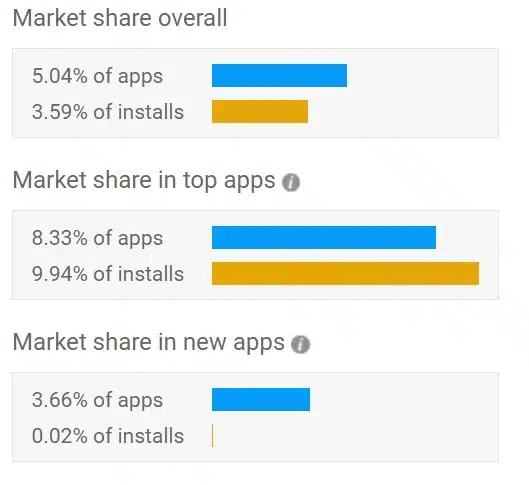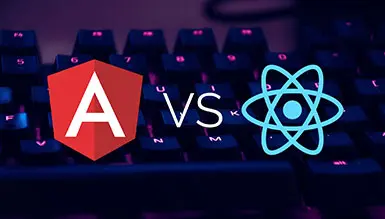Facebook’s introduction of the React Native framework for mobile app development has generated tremendous excitement in the app industry. Both business and technical leaders must have a firm grasp of the importance of React Native development if they want to make their app a success which everyone wants.
The developers at Facebook and Instagram are responsible for React Native maintenance, the native version of the widely used JavaScript framework ReactJS. Among programmers, React Native’s star has skyrocketed in only the past two years. Indeed, it has become the thirteenth most-starred project in the history of GitHub. There is currently a focus on this technology at the react native mobile app development company. Searches for “React Native” have increased in popularity, ranking above “iOS development” and “Android development” in Google’s findings.

Today, software developers are working hard to ensure that their mobile apps are as fast and efficient as possible, a necessity in the increasingly digital world. Mobile app developers have been persuaded to utilize JavaScript, HTML5, CSS, or React Native due to the language’s ease of development and capacity to provide an engaging user experience.
The leading mobile app development companies are bullish about React Native for several reasons.
Why Build Your Next Mobile App with React Native?
1. Support for Multiple Operating Systems
Due to the platform-agnostic nature of most React Native APIs (Application Programming Interfaces), a single component can be used with both iOS and Android. There is no need to write any platform-specific code to create fully functional, native-looking applications. However, there are times when platform-specific considerations are necessary. Design consequences, for instance, vary between the iOS and Android platforms. The Platform component of React and the corresponding file extension are intended for such use cases.
By utilizing the Platform module, we can determine the operating system the app is using and define OS-specific implementations. Files can be defined for systems using platform-specific file extensions. No matter what operating system your app is running on, React will always use the most up-to-current date.
2. Open Source
All of us are aware of the common belief that open-source projects have many people working together to improve them. The same is true of React Native, which boasts an enormous user base thanks in large part to the tireless efforts of its developer community. There is a good chance that members of the React Native community have already built something you want to develop if it is something common in mobile apps.
3. Shorter time between prototype and release
React Native disrupts the development process for mobile apps. There are numerous tools at its disposal. Since it is open source, a sizable portion of the community has adopted it.
Redux, a state management solution, also played a key role in cutting down production times. One way to speed up development and reduce bugs is by using a single data layer for iOS and Android.
4. Live Push Updates and Source Code
One major benefit of using React Native for developing native mobile applications is the ability to implement real-time updates. Instead of waiting for the app store to update, developers can deliver the latest version to the user’s device. The widespread implementation of JavaScript is responsible for this.
Apple’s iOS system is notoriously slow to approve new software versions. However, if you automate app updates for all your users, you will never have to deal with issues related to outdated software.
If you are using React Native, Microsoft’s live update service ,Code Send SDK (Software Development Kit), can be used with your app to push updates to your users. The standard App Store or Google Play procedure must be followed for any update that affects the Native OS (Operating System) (Operating System) side. The only things that can be changed are JavaScript and the assets.
5. Usability and Efficiency
Hybrid mobile applications can be written using a mix of JavaScript, HTML, and CSS. Reacts operate separately from the UI (User Interface) perspective, so these applications can keep their excellent performance without modifying their capacity.
6. Use the Same Source Code to Create Apps for Multiple Platforms
Using React Native, programmers of mobile apps may write once and deploy to several operating systems. It is hard to imagine a better scenario for software engineers than being able to create apps that run on several platforms while simply learning and mastering a single set of tools. It aids in recouping the biggest drawback in this way.
7. Speeds up the coding process
Being able to recycle previously created code is a huge deal in software engineering. The power to do so is within your reach, thanks to React Native. I am not suggesting that you can “write once and utilize on all platforms” with React Native. Your job as a developer requires you to create new code to create a user interface that is visually and functionally native to each platform, adhering to each one’s standards and best practices. The nicest aspect is that some of the user interface code is shared between the two platforms.
8. Accessible Materials
Since JavaScript is one of the most popular and rapidly expanding programming languages, it is simple to find developers who can design mobile apps utilizing React Native with a focus on performance.
9. Support for a Wide Variety of Devices with a Single Framework
By contributing new open-source tools, the react native developer community provides consistent backing for the framework. With React Native, you may share your code between iOS and Android or simply various parts. The reality is that while certain features will require custom development, others can be found in pre-made add-ons for the program itself.
10. Quick Reloading Time
By implementing Hot Reload, React Native has increased productivity and decreased development time. A developer can keep the program live while updating it and making UI changes.
11. Better development Environment
As a result, the React Native environment has become more popular among developers. Eliminating boring tasks like rebuilding and deploying from the development cycle improves the overall experience. Flexbox is used as the layout engine for React Native on both iOS and Android. You need to understand one layout engine to design for iOS and Android.
12. Cover Two Major Ecosystems
The iOS and Android environments are dissimilar. Building such a platform is difficult and complex. Since this is the case, creating native apps for them is considered a major headache for programmers. Since developing for the iOS platform needs fluency in Swift or Objective C, while developing for the Android platform necessitates fluency in Java and the Android software development kit (SDK), developers must choose one of these languages to focus on. You will also have to go through the hassle of constantly learning about and implementing new features in these two key ecosystems. On the other hand, technological advances mean that no problem is permanent.
Our experts can help you in developing your world-class Mobile Applications..
Why Is React Native So Popular?
As a result of its superior performance, enhanced user experience (UX), and broad accessibility, React Native is receiving widespread acclaim. Facebook’s support for this robust language guarantees it will be there for the long haul regarding actual work on the back end.
React Native is a framework solely concerned with user interface, unlike MeteroJS and AngularJs. Apps developed with React Native have a user interface that is quick to react. With React Native and the device’s native environment, your app will load faster and run more smoothly.
React Native is a mobile framework created by Facebook that is helping app developers all around the world develop ground-breaking apps for their customers. Even more, React Native works with a wide variety of third-party components. Download a third-party plugin and connect it to a native module to add Google Maps support to your program. Additionally, your app makes effortless use of the device’s in-built features, including rotation, zoom, and the compass.
Apps Created with React Native

1. Skype
When the Skype app was launched, it had a lot of issues, which is why the announcement of a new app built with React Native was made. Skype’s interface has been modernized down to the icons so users can reap the benefits of the app’s many updates at once. Microsoft, seeing the value of React Native, has announced that it will be considering the framework not only for Windows on PCs but also for Windows on mobile devices. Not only that, but Microsoft now has access to React Native’s impressive benefits thanks to the GitHub repo’s acquisition of React Native.
2. Facebook Ads
React Native was developed as a mobile app for Android users under Facebook’s wing before it began officially supporting social networking platforms. It might handle problems with many business logic necessities, such as handling several time zones, ad formats, date formats, currency conventions, currencies, and more. New or updated React Native capabilities in Facebook advertising inspired other developers to try to incorporate them into their apps.
3. Facebook
Facebook’s goal with this feature was to provide mobile users with a lightweight version of the web interface they enjoy on desktop computers. Facebook intended to use a unified mobile app development service. Therefore, Facebook’s mobile app development utilized React Native for iOS and Android users. The new functionalities were thoroughly tested, and the development team behind React Native verified their efficacy. This update is crucial since it will determine whether the user continues using the app. It is only one example of a change made with React Native; many other capabilities were also used by users.
4. Tesla
Tesla, the most well-known maker of electric vehicles, has just begun working with the react-native community on an app for its vehicles and Powerwall battery. They used the Facebook trending framework as a reference. The Tesla software can analyze a vehicle, pinpoint its location, and allow users to use their smartphone to operate a subset of the car’s functions. Despite the full scope of their app development being unknown, the notion has been met with enthusiasm from customers so far.
5. Instagram
One of the services that fall under the umbrella of “react native app development” is Instagram. It overcame the hurdle of incorporating react-native into its existing app by completely revamping the UI from the ground up.
You don’t need additional navigational framework because of redefined user-interface. While adding support for the React Native app’s capabilities into Instagram was no easy accomplishment, the development team gradually boosted the app’s speed despite facing several challenges along the way. App development services organizations can save significant amounts of time by sharing between 80 and 90% of their code between iOS and Android.
6. Shine
If you are feeling overwhelmed and uninspired, Shine is one of the finest react native applications for calming your mind. They can unwind while reading inspiring proverbs, mottos, and articles. When people use the app at the end of the day, they hear spiritual or motivational recordings chosen by experts to help them relax. Because Apple was the market leader at the time, this software was first only available on iOS, with a focus on the American market. To facilitate a speedy port to Android, the team enlisted the help of react Native, a framework that facilitates the smooth transfer of code between iOS and Android.
Advantages of Building Native Apps with React
Developing mobile apps with React Native has several advantages, which are as following
1. Compatibility with Cross-Platforms
Each native development service has an interface that allows team members to pick up where they left off and continue working. This group allows for greater adaptability and streamlining of the mobile app’s process of updating and upgrading.
2. It is a cost- and time-saver
It is a time-saver for software engineers because React Native makes it possible for businesses to have apps for both Android and iOS. They save time by not having to develop two versions of the software, one for Android and one for Apple’s iOS. Since this eliminates the need for developing many programs, it also reduces costs.
3. Excellent Performance
While conventional operating system (OS) operations rely on the central processor unit (CPU), React Native apps can benefit from the additional processing power provided by the GPU. However, because of the way the React Native app’s code is optimized for mobile devices, it offers identical performance to a native app developed for a particular mobile operating system like Android or iOS.
4. View Changes immediately
React Native has a feature known as live or hot reloading. It allows programmers to preview their modifications to the code in a concurrent window. Moreover, developers benefit from this because they receive immediate feedback at every stage.
5. Movable
This is a significant reward of adopting React Native to create an application for beginners from scratch since it provides great adaptability to the activities involved. These apps ethically export from React Native and can be continued in Android Studio or XCode.
React Native’s Downsides
We have discussed several advantages of React Native above, but we all know that there’s a minus for every plus. The disadvantages of using React Native are as follows.
1. Immature Framework
We all know that with each upgrade or release comes a slew of major changes, which can be taxing for the developers. While React Native is the more recent and speedy choice, it is becoming too immature for serious IOS and Android app development.
2. It is Difficult to Figure Out the User Interface
React Native is not an ideal option if your mobile app requires animation, multiple screen transitions, and interactions.
3. Debugging Difficulties
There are a lot of difficulties in debugging React Native-built mobile apps. The primary cause is that these programs are developed using C/C++, Java, and JavaScript.
Summary
When it comes time to hire mobile app developers—especially React Native developers —the app development organizations always look for the best possible price. It is easy to create high-quality mobile apps with React Native. Numerous software development firms have recently made a move to using React Native. The vast resources available and the rapidly expanding community indicate that React Native will soon be the standard for mobile app development services.
JumpGrowth’s React Native team undergoes rigorous screening before being interviewed and given additional training to ensure they are ready to contribute as full-fledged software experts.
We have higher expectations for our developers here at JumpGrowth. In the same way, elite special forces units cherry-pick the most capable members from the regular military; we only hire developers who have proven themselves to be genuinely great. We take their abilities and hone them even further.
If you hire from JumpGrowth, you can get the benefits of a full-time developer with years of experience and the help of a project manager for a fraction of the cost.
Our experts can help you in developing your world-class Mobile Applications..


























